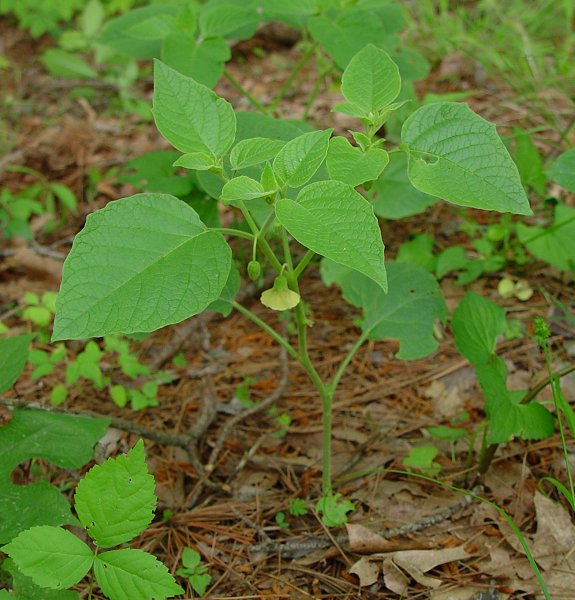Physalis heterophylla Nees
Clammy Ground Cherry

Native
CC = 3
CW = 5
MOC = 85
© DETenaglia
Physalis heterophylla NeesClammy Ground Cherry | |
 |
Native CC = 3 CW = 5 MOC = 85 |
© DETenaglia |
|
Family - Solanaceae Habit - Perennial forb with deep-set, long-creeping rhizomes. Stems - Ascending to erect, to 1.0 m, unbranched or with few to many, loosely ascending to spreading branches, densely pubescent with varying proportions of shorter, gland-tipped and longer, nonglandular hairs, variously 0.1-2.0 mm long, spreading, multicellular.
Leaves - Alternate, simple, petiolate. Petioles to 1.5 cm, pubescent as the stem. Blades 3-12 cm long, broadly ovate or nearly circular, angled or short-tapered to a sharply pointed tip, broadly rounded to more or less truncate or shallowly cordate at the base, the margins entire or sparsely to moderately and irregularly toothed, glandular- and nonglandular-hairy, the teeth bluntly to sharply pointed, coarse, relatively shallow and broad, the surfaces green to dark green when fresh, moderately to densely pubescent with short, gland-tipped, and longer, nonglandular, multicellular hairs.
Inflorescence - Single flowers from the leaf axils. Flowers usually pendent. Flower stalks 9-15 mm long, becoming elongated to 20-30 mm at fruiting, densely glandular-pubescent. Flowers - Calyces 6-12 mm long at flowering, the lobes 3-6 mm long, the outer surface with dense, multicellular, long, nonglandular hairs and often also short, gland-tipped hairs at flowering. Corollas 10-17 mm long, pale yellow to lemon yellow or yellow, the inner surface with 5 prominent purplish brown to bluish purple spots toward the base, these often merged into a ring or appearing smudged. Stamens 5, with broad, club-shaped filaments about as wide as the anthers, the anthers 2.5-4.5 mm long, yellow, rarely bluish-tinged or each anther sac with a bluish longitudinal line along the zone of dehiscence, arched but not coiled after dehiscence. Ovary superior, yellow, 1.5mm long, 2mm in diameter, glabrous, subtended by a green nectary, 2-locular, placentation axile.
Fruits - Fruiting calyces persistently hairy at fruiting, becoming elongated to 25-40 mm long, shallowly 10-angled or 10-ribbed, shallowly concave at the base, mostly remaining green, occasionally pale brown to tan with age. Fruits berries 0.8-1.2 cm long, globose, green or yellow, viscid.
Flowering - May - September. Habitat - Streambanks, upland prairies, loess hill prairies, sand prairies, glades, bottomland forests, forest openings, marshes, fens, fields, pastures, quarries, railroads, roadsides, open disturbed areas. Origin - Native to the U.S. Lookalikes - Many other species of Physalis. Other info. - This species of ground cherry can be found throughout Missouri. Its range beyond Missouri includes most of the eastern 2/3 of the continental U.S., though it is less common in the deep South. The plant is easily recognized as a Physalis by its characteristic yellow flowers having dark centers. Differentiation of species within the genus requires attention to the corolla size and color, the nature of pubescence (if any) on the plant parts, and whether the plant is annual or perennial. In this case, the flowers are relatively large and marked with conspicuous dark spots at the center. The foliage tends to be limp and clammy to the touch due to the presence of dense glandular hairs. The leaves are relatively broad. The number of nerves on the fruiting calyx can also be important; usually there will be either 5 prominent nerves or 10 weaker nerves. This species has the latter. Photographs taken at the Current River Conservation Area, Reynolds County, MO., 7-15-01, and in Ellington, MO., 6-5-03 (DETenaglia); also at Riverlands Migratory Bird Sanctuary, St. Charles County, MO, 7-16-2015, and at Millstream Gardens Conservation Area, Madison County, MO, 9-3-2020 (SRTurner). |